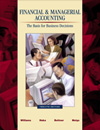Chapter 17 - Summary LO 1 Explain the purposes of cost accounting systems. Cost accounting systems provide information useful for managing the activities
that consume resources. Managers use the information to evaluate and reward
employee performance. In addition, the cost information is reported on external
financial statements as, for example, inventories, cost of goods sold, and period
expenses. LO 2 Distinguish between the processes for creating goods and services that are
suited to job order costing, process costing, and activity-based costing. Job order costing methods are appropriate for businesses and companies producing
customized jobs that require differing amounts and types of direct labor, direct
materials, and overhead. Process costing is used for production processes that
produce mass quantities of identical units that use the same amounts and types
of direct labor, direct materials, and overhead. Activity-based costing is used
to track resources that are not directly traceable to the product or service
produced. Overhead items are typically the focus of ABC methods. It is not uncommon
to find all of these costing methods being used by the same company for different
purposes and costs. LO 3 Describe the purpose and the content of a job cost sheet. The purpose of a job cost sheet is to keep track of all manufacturing costs
relating to a particular job. Each job cost sheet shows the cost of all the
materials, direct labor, and factory overhead charged to the job. The job cost
sheets of all jobs in process serve as a subsidiary ledger supporting the balance
of the Work in Process Inventory controlling account. LO 4 Account for the flow of costs when using job order costing. Costs flow from the Direct Labor account, the Direct Materials Inventory account,
and the Manufacturing Overhead account into the Work in Process Inventory account.
As jobs are completed, the accumulated costs are transferred to the Finished
Goods Inventory account. As units are sold, their costs flow from the Finished
Goods Inventory account to the Cost of Goods Sold account. LO 5 Account for the flow of costs when using process costing. Costs in process costing flow in basically the same manner as costs in a job
order cost system. Throughout the period, the costs of direct labor, direct
materials, and manufacturing overhead are charged to the appropriate Work in
Process accounts. At the end of each period, costs in each Work in Process account
are transferred to the next Work in Process (or Finished Goods) account, representing
the cost of units on which processing has been completed. LO 6 Demonstrate how equivalent units are computed. Equivalent units are measures of productive activity that include work performed
on partially completed units. The basic idea is that performing, say, 50% of
the processing on 500 units is equivalent to performing all of the processing
on 250 units. LO 7 Demonstrate how costs are assigned to equivalent units using process costing. Costs associated with beginning work in process from the previous period and
costs added to work in process for the current period are pooled for each significant
input. Dividing total costs by total equivalent units provides cost per equivalent
unit for each input. The equivalent units associated with the units transferred
out are multiplied by the cost per equivalent unit to determine the amount of
cost to transfer out. LO 8 Define activity cost pools and provide several examples. Activity cost pools are the costs of resources consumed by an activity that
is necessary to produce a good or service. Types of overhead activity cost pools
include building maintenance, utilities, purchasing activities, and machinery
repairs, among others. LO 9 Demonstrate how activity bases are used to assign cost pools to units produced. Activity bases are the measures of the activity that consumes the associated
resource cost pool. Thus, for the purchasing activities cost pool, the activity
base is the number of purchase orders processed. Dividing the activity cost
pool by the activity base provides the cost per unit of activity. Activity costs
are assigned to the product by tracking the activity base associated with the
product and multiplying it by the appropriate cost per unit of activity. In this chapter we have emphasized the measurement of unit costs. In upcoming
chapters, we will see how managers control these costs and utilize cost information
in planning and decision making. | 


 2002 McGraw-Hill Higher Education
2002 McGraw-Hill Higher Education